What keeps the work of art from becoming didactic, that bitter put-down? (We’re meant to learn from art, yes, but we’re not meant to know it’s teaching us.) Luis Camnitzer’s answer would likely be ‘elegance’. For more than 40 years Camnitzer’s work has escaped the fate of what we could call the ‘teacherly’ by courting simplicity and economies of means in works that range from the archly self-reflexive (note the artist’s ‘self-portraits’, one executed each year for five years between 1968 and 72, in which Camnitzer offers only a stencil drawing of his own name and the word ‘selfportrait’) to the slyly poetic (in Seven Virtues, 2014, Camnitzer inserts definitions of seven cardinal virtues – charity, humility, patience, etc – into the pages of Dorland’s Medical Dictionary).
The Mediocrity of Beauty, then, which is the title of a 2010 essay in which Camnitzer pits the concept of elegance against beauty, is as much an argument for Camnitzer’s own approach to artmaking, and thus his own work, as it is an argument about the stakes for art in general. The elegance that Camnitzer appreciates, and which his work strives for and often achieves, is not the kind that we could confuse with matters of taste. There are no elegant interiors to be admired here, only solutions to conceptual problems, some of which deserve the modification of ‘elegant’, and others which don’t.
Of the latter category, Please Look Away (2015) is exemplary. A matrix of black vinyl bands that crisscross the gallery’s floors and walls and that bear awkward and sometimes ominous sentences and phrases – ‘Prowling bacteria everywhere’, ‘I’m peeking through the holes of my eyes’ – Please Look Away, one senses, is meant to confront us with the visceral affect of language, but it bears nothing of the spark to one’s thoughts that comes with reading the definition of ‘hope’ among those for ‘hordeolum’ (a staph infection at the edge of the eye) or ‘Hong Kong foot, influenza’. Is ‘hope’ just another malady? Is it a cure? What doctor would come across the word and need to look it up? And where is the entry for ‘hope, caution against’? It’s thoughtprovoking, not a prompt. (Really, ‘prowling bacteria everywhere’ only puts me in mind of Internet chatrooms and comment boards.)
In a recent lecture, Camnitzer said that ‘art is the ultimate tool for critical thinking’. Though he subordinates science to art (science requires logic and empirical repeatability, art does not, so it naturally constitutes a greater set of possibilities and outcomes), science remains the model for Camnitzer’s concept of elegance. The well-posed problem, the elegant solution – this is the game he is after, even if the game he is playing doesn’t have the same kinds of rules, the same kinds of collective commitments that scientists do.
What is one to make of beauty, then? The two works that tempt this mediocre category are Symmetrical Jails (2014) and Jane Doe (2012/15). Jane Doe gives its audience a digital composite portrait of a woman’s face, the constituents of which have been drawn from newspaper articles, legal documents and police reports. Text from these sources scrolls along the bottom of the screen, suggesting an at-turns horrific or banal or bizarre narrative to go with the unremarkable visage. The composite photograph would seem to be an odd choice for a contemporary take on beauty, and too literal a manifestation of ‘mediocrity’. Today the mediocrity of beauty, in photography at least, is the province of the retouch artist. Composites are too nineteenth-century. But in Symmetrical Jails, for which Camnitzer composites all the letters of the word ‘symmetry’ in seven different languages, the results are far from mediocre, and yet beautiful nevertheless.
This article was first published in the April 2015 issue.
